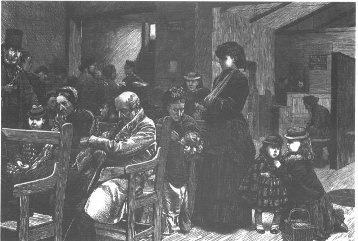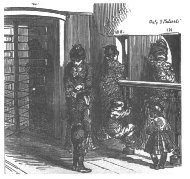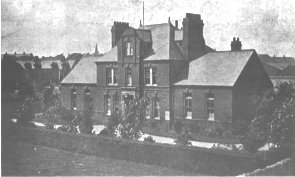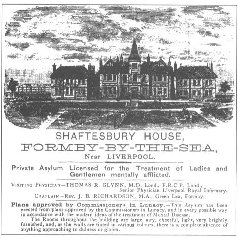In the early part of the period, hospitals, rather than being seen as "places of healing" were more often viewed as "gateways of death". A visitor to such an establishment would see overcrowded wards, surgery being performed without anesthesia and his having placed himself at risk of catching a deadly infection or virus.
The wealthy were able to pay a doctor to attend them at home, while the poor had no choice but to go to a charitable hospital or workhouse infirmary. At that time a hospital was either a charity or run by local authorities and there were only a handful of such facilities in all of England.
Before 1850, there was a high potential for the spreading of disease within the hospital environment itself. It was believed that foul air, or miasma, caused infection. It wasn't until the middle of the century that the idea was challenged blaming the spreading of disease on germs.
Hospitals were designed with small rooms off a main corridor as it was thought that the smaller wards would help prevent the spread of disease and infection. This, however, did little in the prevention as these rooms would also be overcrowded with patients due to the lack of space. Few surgeries were performed as success rate was extremely low and prior to anesthesia extremely painful.
Advances started to be made in the field when Joseph Lister discovered "antisepsis" to prevent wounds and incisions from becoming infected. The Medical Act of 1858 made a group called the General Medical Council responsible for establishing a register of qualified doctors. Prior to that time, they were "elected" by a commission with no control or defined standard of qualification.
Several different types of hospitals evolved out of need as voluntary hospitals did not treat all diseases or the mentally ill. These hospitals consisted of the Voluntary hospitals, Specialist and cottage hospitals, Poor Law infirmaries, Hospitals for Infectious Diseases and Asylums for the mentally ill.
The Voluntary Hospital
The voluntary hospital began as a charitable institution initially developed to serve the poor without charge. They were funded by donations and subscriptions from wealthy benefactors. It was governed by a committee of benefactors who appointed the staff.
 Admission was not initially determined by the doctor, but upon the receipt of a letter of recommendation by the committee of benefactors who accepted this assignment of power as influencing their social status in the community. The letter system was later dropped as it was seen as an obstacle to the admission of urgent and deserving cases. The patient now presents himself at the hospital where he is evaluated by a doctor regarding the extent of medical attention required and then interviewed as to financial circumstances.
Admission was not initially determined by the doctor, but upon the receipt of a letter of recommendation by the committee of benefactors who accepted this assignment of power as influencing their social status in the community. The letter system was later dropped as it was seen as an obstacle to the admission of urgent and deserving cases. The patient now presents himself at the hospital where he is evaluated by a doctor regarding the extent of medical attention required and then interviewed as to financial circumstances.
These hospitals turned away the truly destitute as well as those who could afford to pay for the services. Also turned away were the incurables, the chronically or mentally ill, and those with infectious diseases. They did, however, accept "accident" patients and were compensated by businesses to treat these individuals on a priority basis.
Doctors working in these types of hospitals are not compensated. They make their living from private practice.
 By 1860 medical advances contributed to many more successful operations and more of the wealthier people wanted to be treated in the hospital. This type of hospital included in addition to the patient wards, an operating theatre, an anesthesia room as well as a pharmacy. Patients are required to pay something for the medicines they receive. There is also a kitchen, a laundry, a mortuary and a chapel.
By 1860 medical advances contributed to many more successful operations and more of the wealthier people wanted to be treated in the hospital. This type of hospital included in addition to the patient wards, an operating theatre, an anesthesia room as well as a pharmacy. Patients are required to pay something for the medicines they receive. There is also a kitchen, a laundry, a mortuary and a chapel.
Also around this time, benefactor donations began to dwindle and the cost of operating put these types of facilities in crisis making it necessary to find alternate means for financing. Hospital Saturdays and Hospital Sundays were established as appeals for fund-raising and also the charging of fees for a bed as well as subscription programs (the first medical insurance?) for future service.
Specialist/Cottage Hospitals
Around 1850-1860, Specialist hospitals began to evolve out of the need for caring for certain medical conditions which were excluded by the Voluntary hospitals. These types of hospitals were started occasionally by relatives of those who had been afflicted by one of these conditions as well as doctors themselves who had an interest in a particular medical issue. Unlike the Voluntary hospitals, it was the doctor who determined admission to these facilities. Also, the benefit of treating many cases of a particular disease enabled further inroads in medical research.
Prior to this time, it was believed that the best doctors were those who were competent in everything and in the 1860s the "British Medical Journal" ran a campaign against specialist hospitals arguing that it drew away interesting cases from the general hospitals (which of course had been turning these cases away) harming the education of medical students.
Another benefit of treating many cases of a particular disease enabled further inroads in medical research and now the value of taking a specialist's advice is much appreciated.
 The 1850s-1860s also brought the creation of the Cottage Hospital which began to develop in the rural areas to reduce the distance people had to travel to get to a hospital. The patients in these hospitals are serviced by a general practioner and have between six to twenty-five beds. Modest weekly sums are charged for the services provided by these facilities. The first of these cottage hospitals opened at Cranleigh in Surrey in 1859. By 1875, 148 cottage hospitals were opened.
The 1850s-1860s also brought the creation of the Cottage Hospital which began to develop in the rural areas to reduce the distance people had to travel to get to a hospital. The patients in these hospitals are serviced by a general practioner and have between six to twenty-five beds. Modest weekly sums are charged for the services provided by these facilities. The first of these cottage hospitals opened at Cranleigh in Surrey in 1859. By 1875, 148 cottage hospitals were opened.
Poor Law Infirmary
The Poor Law infirmaries are hospitals within the workhouses. The 1834 Poor Law required that all who wanted public relief enter the workhouse. By 1845 a law set forth in Scotland made these types of facilities responsible for maintaining medical care. As it was the desire at the time to keep these facilities as severely poor, conditions at the workhouse infirmary were far worse than at any other type of medical facility. It was here where the aged or incurable sick often ended up.
The doctors in these workhouse infirmaries were salaried, unlike those at the voluntary hospitals; however, it was difficult to recruit doctors for these posts. Doctors visited these facilities only once or twice a week with the daily care the responsibility of nurses.
It wasn't until the Metropolitan Law Amendment Act of 1867, which forced the removal of such medical facilities out of the workhouse itself to its own facility. Despite these changes, these Poor Law Infirmaries ranked lowest in the performance of medical care.
Hospitals for Infectious Diseases
In order to prevent the spread of infection, special hospitals were established to isolate patients with contagious diseases. Some of these hospitals were run under the control of the local Medical Officer of Health, and others within the workhouse. In many instances, there was no charge to the patient to encourage them to enter the hospital in order to protect the public from exposure.
Asylums
The mentally ill are accommodated in asylums, provided for by public funds as the result of the 1808 County Asylums Act. Prior to this time, mental disease was not recognized as an illness and those afflicted were treated as criminals, paupers and vagrants. In 1845 legislation made the provision for county asylums mandatory, funded from the local poor rate.
disease was not recognized as an illness and those afflicted were treated as criminals, paupers and vagrants. In 1845 legislation made the provision for county asylums mandatory, funded from the local poor rate.
To prevent abuse, Lunacy Commissioners were appointed to make regular inspections across the country. For financial reasons, by 1870, it became the policy of leaving harmless cases in the workhouse and sending away only the dangerously insane to the asylums.
|
|
|
|
|
|
|
|
Back to Intro/Index or Site Map
| | Family Gallery | Servants Parlour | Tour Home | Typical Day | Etiquette | Shopping Trip | |
| | Victorian Christmas | Victorian England Fun and Games | Ashton Library | Victorian Wedding | |
| | Victorian England Overview | Guest Registry | Honorary Victorian | Tours | |
| | Awards Received | Bibliography | |
| | 1876 Victorian England Home | |
Credits below copyright information |
| Contact
webmaster |
| Copyright
1999-2017 All Rights Reserved - B. Malheiro May not be reproduced in any way without express written permission of webmaster. |
Credits:
Background and buttons are the creation of webmaster, B. Malheiro. These images have been watermarked and are not for use on another site. Site authored by webmaster.